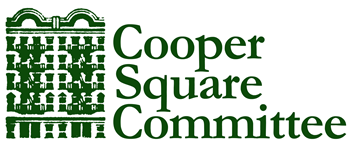For Immediate Release
Contact:
Brandon Kielbasa, (212) 228-8210, bkielbasa@coopersquare.org
Jodie Leidecker, 347-450-0574, jodiel@coopersquare.org
Is Your Building One Of the 75% Of NYC Buildings With Lead Paint In It?
New Easy-To-Use Data Tool Helps Tenants Understand If Their Building Could Be A Source Of Lead Exposure
Formerly Opaque Process Of Determining If A Tenant Is At Risk Of Lead Exposure In NYC Improved As New Lead Map Quickly Helps Tenants Evaluate Risk
New York, NY –– Tenant-led Lead Dust Free NYC (LDFNYC) coalition and Cooper Square Committee, in conjunction with BetaNYC, have released a new digital lead map which allows tenants to type in their address and quickly determine if they are likely at risk for lead exposure in their homes. Based on the age of buildings, the map instantly clarifies if a tenant’s home has a presumed presence of lead paint in it.
Link to new map tool: coopersquare.org/leadmap
Prior to the creation of the map, most tenants would have to be very knowledgeable about how to research not only the age of their building, but also find relevant information about how likely it would be to contain lead based on that age. Now, they can type in their address and instantly gain some insight into this important information.
In spite of stricter regulations coming into law in the decades since the landmark Local Law One of 2004, thousands of NYC’s children – 5,078 children under the age of 6 years of age in 2023 – are still lead poisoned every year and countless other tenants are needlessly exposed to lead through cracking and chipping paint, and especially in intense bouts of reckless construction that create clouds of lead dust.
Children are not the only age group impacted by lead. More information is becoming available about how lead exposure is bad for adult health as well. However, as noted in LDFNYC’s 2024 report on construction dust in NYC’s residential buildings, adults exposed to lead in their homes have little recourse because they are only covered by federal protections that are not generally enforced in NYC. In addition, when penalties are imposed, they are weak and most go uncollected.
Thus, LDFNYC has worked to make this map tool available to provide critical information about which buildings may have lead paint in them. The aim is to make the information easily accessible for tenants. Tenants who use the map find out they live in a building with a presumed presence of lead paint in it can reach out to CSC or their other local tenants’ rights organizations for advice about how to handle lead paint noted in their home. Contact CSC at LDFNYC@coopersquare.org for this kind of assistance.
“My building was constructed around 1900 and this valuable map tool allowed me to search the likelihood of lead paint on the premises. The quick reference visual also showed that adjacent residential structures formed a cluster of sites potentially harboring lead paint. So important for tenants and neighbors to be forearmed with this information. When walls are being breached for repair or renovation you need to know about possible exposure to lead and that no level of exposure is safe.” said Anne Hayes, a long-time LDFNYC leader.
“Knowledge is power,” said Morri Markowitz, director of the Lead Poisoning and Prevention Program at Children’s Hospital at Montefiore. “This lead map empowers tenants.”
“Almost every aspect of protecting yourself and your family from lead paint hazards starts with a basic education about where lead paint exists in our housing,” said Brandon Kielbasa, Director of Organizing and Policy at the Cooper Square Committee. “This map is an easy to use tool which helps you determine if your building has a presumed presence of lead paint in it. Far too many landlords cut corners when handling lead paint in their properties. The information this map provides will allow you to advocate for yourself and hold your landlord accountable for handling any lead paint in your home properly.”
“Only after intense work on the part of tenants have I ever seen landlords attempt to follow the rules for lead safety,” said Jodie Leidecker, organizer at Cooper Square Committee. “Now with this map and the accompanying information, tenants will be forewarned about potential lead hazards and can take steps to protect their health.”
ABOUT THE COOPER SQUARE COMMITTEE
The Cooper Square Committee (CSC) works with area tenants to contribute to the preservation and development of affordable, environmentally healthy housing and community/cultural spaces so that the Cooper Square area remains racially, economically, and culturally diverse. The Cooper Square Committee has spearheaded significant neighborhood victories in our history, comprising 50 years of tenant organizing, community-based planning, advocacy and development. We rely on the active involvement of our members in the organization’s work to advance our affordable housing agenda.
ABOUT BETANYC
This project was designed and developed by BetaNYC’s Civic Innovation Lab in collaboration with the Cooper Square Committee, through a BetaNYC service called Research and Data Assistance Request (RADAR). BetaNYC is a civic organization dedicated to improving lives in New York through civic design, technology, and data. With an aim to improve access to public interest technology, the Civic Innovation Lab at BetaNYC provides assistance with research, data analysis, and data visualization.
###
